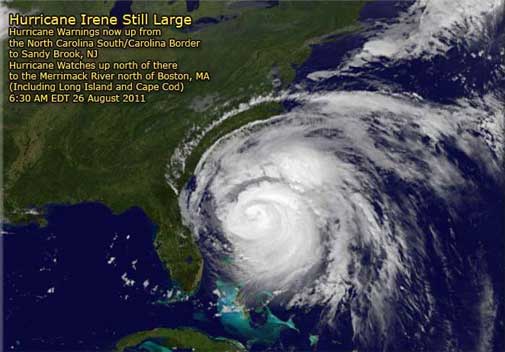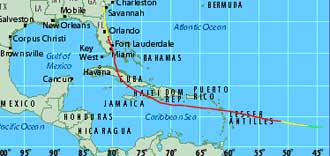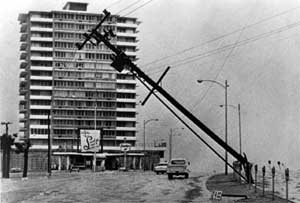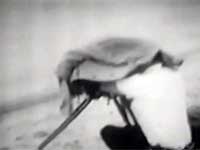
[SUNDAY UPDATE: Lost power, but not resolve. And while the non-powered sump pump had me up before daybreak, toting buckets of water from the basement like those brooms in Fantasia, I have no complaints. Yet... And thanks to Dunkin' Donuts, for being the only place open just after the hurricane hit. Thanks for the coffee, AND the free WiFi... - DB]
Even before Friday morning reports began downgrading dramatic estimates about the force and path of Hurricane Irene, I was ready to await that hurricane -- which initially seemed aimed straight for my house in Cherry Hill, NJ -- and stare it right in the eye.
As Huckleberry Finn said at the end of that Mark Twain novel, "I been there before"...
In my case, I was raised in Fort Lauderdale, FL, where hurricanes seemed part of the natural weather cycle -- our version of something to count on each season. The North had winter and snow; we had wind and rain. Lots of it...
For me, the mother of all hurricane-graded storms was Hurricane Cleo, which hit Florida in August 1964, when I was 10 years old. It was only a Category 2 hurricane (they're ranked, low to high, from 1 to 5), but Cleo was something special.

She decided, after making landfall in Florida in Key Biscayne, to head north like she was driving on State Road 7 (and, with winds of 110 mph, totally ignoring the speed limit). That put the eye of the storm directly over my house.
Preparation for the storm's arrival was the same as for all others, before and after, while I lived in southwest Lauderdale. Storm shutters down, exposed sliding glass doors boarded or taped, bathtubs filled with water, canned and dry goods stocked up, candles and matches at the ready, fresh batteries in the transistor radios.
From the inside of a house, when you're a kid, hurricanes are cool. You usually lost power early, so board games were played by candlelight - and most windows were blocked off, so you couldn't see outside, only hear. It was a roar that sounded, at times, like an oncoming train. But at least the way my dad orchestrated things at our house, a hurricane was something to respect, but not to fear. He tried to make them fun, at least for my older sister and me, and succeeded.

But Cleo, when the radio told us the eye was directly over our area of town, served up something unique to our experience. After listening to radio reports of downed power lines, flooded roads, breached seawalls and caved-in buildings all over the area, we got a different perspective.
All of a sudden, my dad opened the front door and let us go outside.
The streets were totally flooded, but that would happen even after a regular rain. The sky wasn't cloudy; it was like one big cloud, everywhere you looked. And there was no sound whatsoever. No birds -- that's what I remember the most. Where had they gone?
While I was looking for birds, my dad was looking at the wooden fence around our side and back yard. Hurricane Cleo's winds had bent the wooden planks down to the ground, held together only by the horizontal braces that held the fence together. The nails on those braces had been lifted almost entirely out of the wood -- and that's when my dad went to his workbench and returned with a pair of hammers.
Handing one to me, he instructed me to start hammering. And we worked our way around the property, nailing the nails back into the braces and posts, with the fence itself still flattened on the ground. I didn't know why, as we returned to safety before the storm returned -- but when Cleo came back, the winds were pushing in the opposite direction.
Damned if that fence, when the storm was over, hadn't blown back to an upright position. Well, almost upright. It looked kind of like a Dr. Seuss fence, with its own animalistic curvature. But that was fine for us, and it stayed that way until we moved.
After the storm, Miami TV station WCKT presented a special assessing damage and reporting on its own reportage. Parts of it are available on YouTube, if you'd like to compare hurricane coverage from nearly half a century ago:
You can go back even earlier on YouTube, to the first major hurricane I experienced, with coverage of Hurricane Donna in 1960.

It's amazing, in retrospect, because it shows that though the equipment and technology have changed drastically, the idiotic impulse to station human beings in the direct path of the storm, filming outdoors, has a tradition stretching back more than 50 years.
Here's that 1960 clip, which is hosted by Ralph Renick, still the reigning Miami newsman when I returned to the area, post-college, to begin my full-time career as a TV critic:
There were other big hurricanes during my Florida years, from Betsy in 1965 to a 1992 book tour that had me landing in Lauderdale the day after the Category 5 devastation of Hurricane Andrew.
And here I am, 47 years after Hurricane Cleo, awaiting Hurricane Irene's impending arrival on Sunday. And while the adult in me -- the homeowner -- is happy to hear that the storm trackers now have it heading further east and weakening in intensity, the little kid in me is a little disappointed.
I already have my candles and matches and canned goods, and even a battery-powered emergency-band radio, ready.
And, just in case, I know where my hammer is...